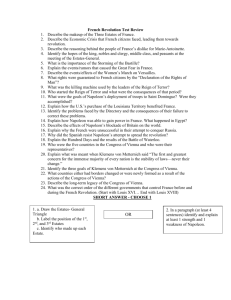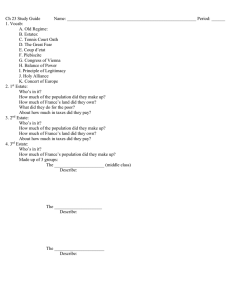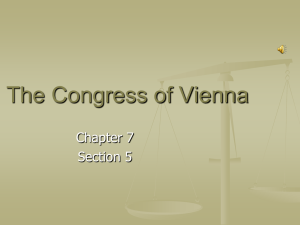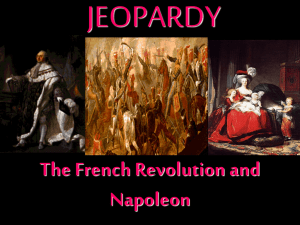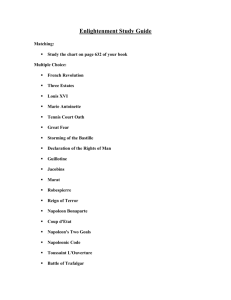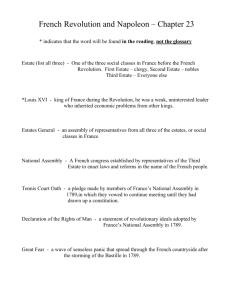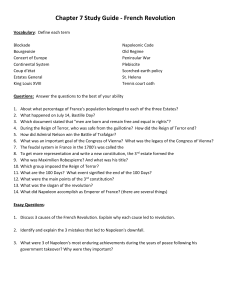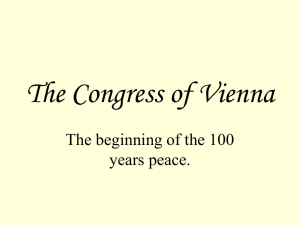Lesson Plan - The French Revolution and Napoleonic Wars
advertisement
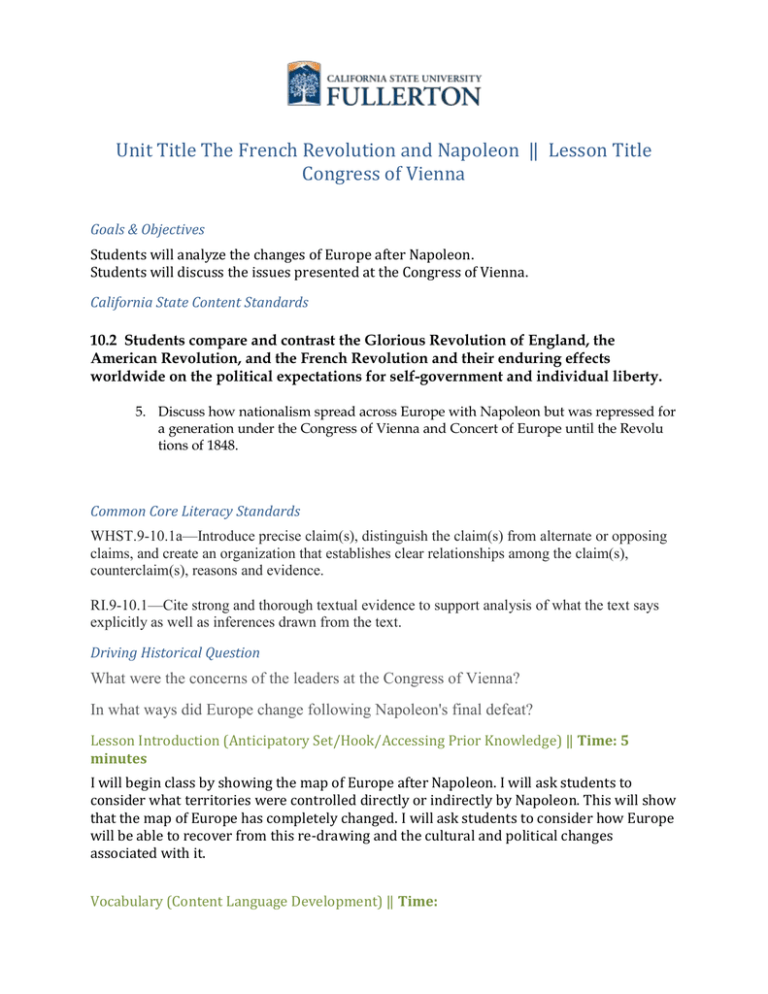
Unit Title The French Revolution and Napoleon ‖ Lesson Title Congress of Vienna Goals & Objectives Students will analyze the changes of Europe after Napoleon. Students will discuss the issues presented at the Congress of Vienna. California State Content Standards 10.2 Students compare and contrast the Glorious Revolution of England, the American Revolution, and the French Revolution and their enduring effects worldwide on the political expectations for self-government and individual liberty. 5. Discuss how nationalism spread across Europe with Napoleon but was repressed for a generation under the Congress of Vienna and Concert of Europe until the Revolu tions of 1848. Common Core Literacy Standards WHST.9-10.1a—Introduce precise claim(s), distinguish the claim(s) from alternate or opposing claims, and create an organization that establishes clear relationships among the claim(s), counterclaim(s), reasons and evidence. RI.9-10.1—Cite strong and thorough textual evidence to support analysis of what the text says explicitly as well as inferences drawn from the text. Driving Historical Question What were the concerns of the leaders at the Congress of Vienna? In what ways did Europe change following Napoleon's final defeat? Lesson Introduction (Anticipatory Set/Hook/Accessing Prior Knowledge) ‖ Time: 5 minutes I will begin class by showing the map of Europe after Napoleon. I will ask students to consider what territories were controlled directly or indirectly by Napoleon. This will show that the map of Europe has completely changed. I will ask students to consider how Europe will be able to recover from this re-drawing and the cultural and political changes associated with it. Vocabulary (Content Language Development) ‖ Time: Congress of Vienna Balance of Power Metternich Conservative The terms will be researched by students in their given groups. Any confusion will be addressed during the class debate. I will periodically pause during the debate and reflect upon the important terms. Content Delivery (Method of Instruction) ‖ Time: 10 minutes I will set the stage for the simulation by reviewing the basic background information about postNapoleonic Europe. I will explain to students that the leaders of Europe were in fear of revolutions spreading. All the major countries were recovering from huge economic and human loss as a result of the many years of war. While feelings of nationalism were sprouting, leaders felt the need to form alliances to protect their power. I will then divide the class into five sections. Each section will take on the role of one the powers that met at the Congress of Vienna (Russia, Prussia, Austria, Britain, and France). Each group will work together to answer some important questions such as How do we make sure France is no longer a threat? How can we avoid future wars? How do we stop future revolutions from occurring? Finally, each group will need to re-draw the map of Europe how their country would best see fit. Student Engagement (Critical Thinking & Student Activities) ‖ Time: 40 minutes Students will work in groups to research their given country and representative. They will work to take notes and answer the three main questions. Students will also draw their ideal version of the map of Europe taking into consideration the goals of their particular country. Students will reconvene in a large circle and take turns answering the questions and taking part in a debate/negotiation led by the teacher. Countries (groups) that agree on certain issues will work to pressure the other countries to agree. This will continue until all major issues have been discussed. Each group will have a representative called upon by the teacher present their map to the class and explain why it would be in the best interest of Europe to accept their boundaries. Lesson Closure ‖ Time: 2 minutes I will call on five students and ask them to give me one word to describe Europe under Napoleon’s rule. Then I will call on five more students and ask them to give me one word to describe Europe after the Congress of Vienna. I will explain that we will further explore these differences in the coming lessons. Assessments (Formative & Summative) There will be a formative entry-level assessment at the beginning of the lesson by answering questions about the map of Europe. As I review previous concepts, I will assess student understanding through questioning. As students work on the map and research, I will walk around the room and check for understanding by observing and questioning groups. I will collect the maps at the end of the lesson and provide written feedback to each group. Accommodations for English Learners, Striving Readers and Students with Special Needs English Learners will work with a group for the main activity. This will help them listen to peers and practice discussing the topic before class discussion. English learners will also have the opportunity to depict their ideas through drawing on the map, if they are not yet comfortable with in-depth writing/conversation. Striving readers will focus on one particular section of the reading and discuss the main ideas with peers. For Students with Special Needs, they will work in groups so if they have social anxiety they can divide the work and the student can focus on something they feel comfortable completing. For instance, the student can choose to find the statistics/ evidence or work on the drawing the map. Finally, the teacher will visit with each group and thus can provide guidance or feedback in an individualized and sensitive manner. Resources (Books, Websites, Handouts, Materials) Textbook, blank map of Europe, colored pencils.
